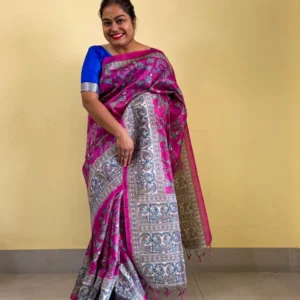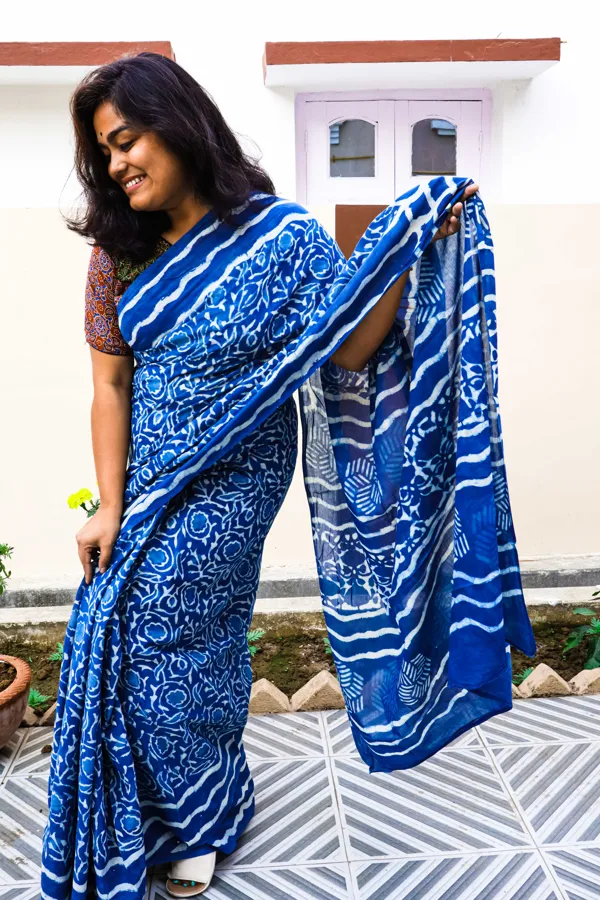The word Dabu is derived from the word ‘Dabaana’ which means to press. It is a technique or craft of creating patterns on indigo dyed fabric using mud as a resist. This craft is usually done in areas that have sticky clay-like soil. Originally these prints were used to design the lehenga and odhni of the women of that area. But today, it is not just limited to odhni and lehengas, Dabu Sarees, a wide variety of garments, and home linen are imprinted with this technique. Some of its main centres are in the states of Rajasthan, Gujarat and Madhya Pradesh.
The craft of Dabu printing is a mud resist hand block process originally done in the state of Rajasthan. Dabu printed fabrics offer a subtle and scintillating beauty and depth that is loved and sought after around the world. It has attracted the attention of modern-day designers across the globe. Dabu printing is nowadays frequently used to decorate many Indian and Indo-western clothes and home décor items.
In the village of Akola, the families living there have been perfecting the technique for generations, and they have always kept the exact ingredients of the original mud resist a closely guarded secret.
History and Origin of Dabu Sarees
The origin of the Dabu printing technique can be dated back to the 8th century AD, as found on the oldest known Dabu textile, in Central Asia.
The craft of hand block printing is an ancient one that is said to have originated in China. It spread all over the globe and eventually in the years it found its way to India, with the state of Rajasthan becoming the sole producer of hand block printed fabrics. In recent times, it is commonly known that the village of Akola, in the Chittorgarh district of Rajasthan, is the originating place of the unique Dabu style of printing that uses mud resists.
Dabu printing is often associated together with other famous and world-renowned Rajasthani hand block prints like Sanganeri and Bagru but is in fact quite different in terms of its aesthetics and production process. The designs are said to be very similar to ‘Batik’.
What is a Dabu sarees?
Dabu sarees are a style of saree that is finished with a design of Dabu style hand block process on them, that sets them apart from all other sarees.
A fusion of Dabu abstract printing combined with modern hand block prints is what makes a Dabu saree so special. Silver sequin work is added on the pallu that makes it a thing of beauty. Usually, in the production of Dabu sarees, natural dyes are used.
The Dabu sarees are designed in an exquisite manner and are made of pure passion for the love of handwoven textiles and organic methods. The designs are very traditional and the fabric is smooth, comfortable, soft and easy to wear.
What are the Varieties Of Dabu?
Dabu printing can create a lot of different designs and patterns. This includes a variety of colours and motifs according to the needs and requirements.
The traditional Dabu prints are made using organic dyes like kashish (grey-brown) and indigo (blue), along with yellow and red which is derived from fruits like pomegranate. Nowadays, many colour options are available to expert craftsmen as they no longer have to use vegetable dyes along with synthetic dyes as well. Fabrics are also dyed more than once if needed, to help create the double Dabu and triple Dabu effect with a glossy, more vibrant appeal.
The traditional motifs printed are of nature-related objects and sceneries, such as peacocks, mangoes, leaves, boota or cornstalks, sunflower (Suraj Mukhi) and other animal figures.
Many different geometric shapes, dots and lines are also used. The designs or patterns that are created, are reiterated over and over again, all over the fabric. Sometimes, the cracks and leaks of the mud paste create a unique vein-like effect that is pretty similar to Batik.
What is the Process of Printing of Dabu Sarees?
The process of Dabu printing is quite taxing, as it involves many artisans and multiple processes that include repeated stages of printing, washing and dyeing.
First, the plain saree is received from the factory and is carefully washed with water to remove any dirt or impurities, that can contaminate the dyeing process. Then, designs are carefully and thoroughly printed by hand onto the saree using wooden blocks, which are dipped in fast dyes.
The next step includes the use of the mud resist which is what makes the Dabu print stand out from others. There are various ingredients used in this stage such as mud, gum, lime and waste wheat chaff, which are mixed in order to make the mud resist paste that is patted over specific parts of the design patterns. Sprinkled sawdust is used to help dry the paste and essentially protects the parts of the saree from the dye that is used, later on, thus creating a stunning and vibrant effect.
After the process of printing is completed, the saree is laid out in the sun to dry. Then the saree is dipped into a vat of dye, and then dried again and finally, the saree is washed thoroughly to remove the paste and excess dye, if present. The dyes that are used in the process are typically natural vegetable dyes and pastes. Thus the parts of the saree that are not covered absorb the colour, while the part covered in Dabu design and patterns remains plain. The fabric is soaked in dye many times in different vibrant colours to give each and every part of the Dabu design a different shade.
Dabu printed sarees have become popular all over the world, owing to their vibrant and scintillating designs, motifs, patterns and shades of various colours. Traditionally, they were exclusively used to decorate high-end sarees made of fine cotton fabrics like Maheshwari cotton, but nowadays they are used for all types of garments and in all kinds of fabrics such as silk, crepe and georgette. All of these blended fabrics and natural alike have become very popular amongst Dabu artisans, mainly because these fabrics capture the designs and colours very well but cotton fabrics still remain the most common fabric that is used for Daboo printing.
The price of a Dabu saree ranges from INR 500- INR 10,000 and more, depending on the fabric used, the motifs and patterns and the required customized designs.
These sarees are very comfortable, elegant but stylish and overall a must wear. These are suitable for all seasons and occasions, as they come in various fabrics, colours and designs.

 Magenta Madhubani Printed Semi Tussar Ghicha Silk Saree
Magenta Madhubani Printed Semi Tussar Ghicha Silk Saree 